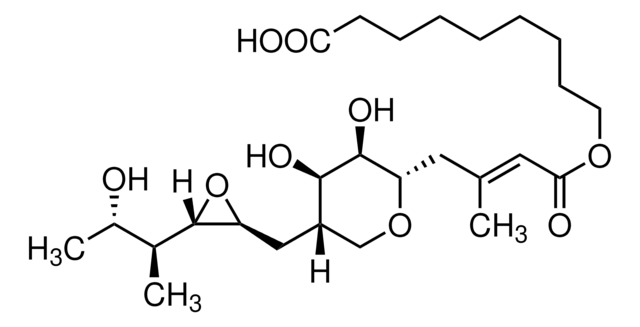Kluczowe dokumenty
F5021
Flunisolide
≥97%
Synonim(y):
6-Fluoro-11,16α,17,21-tetrahydroxypregna-1,4-diene-3,20-dione 16,17-acetonide
About This Item
Polecane produkty
Poziom jakości
Próba
≥97%
inicjator
Roche
ciąg SMILES
CC1(C)O[C@@H]2CC3C4C[C@H](F)C5=CC(=O)C=CC5(C)C4C(O)CC3(C)[C@@]2(O1)C(=O)CO
InChI
1S/C24H31FO6/c1-21(2)30-19-9-14-13-8-16(25)15-7-12(27)5-6-22(15,3)20(13)17(28)10-23(14,4)24(19,31-21)18(29)11-26/h5-7,13-14,16-17,19-20,26,28H,8-11H2,1-4H3/t13?,14?,16-,17?,19+,20?,22?,23?,24+/m0/s1
Klucz InChI
XSFJVAJPIHIPKU-CCRGDLLISA-N
Cechy i korzyści
Hasło ostrzegawcze
Danger
Zwroty wskazujące rodzaj zagrożenia
Zwroty wskazujące środki ostrożności
Klasyfikacja zagrożeń
Acute Tox. 1 Oral
Kod klasy składowania
6.1A - Combustible acute toxic Cat. 1 and 2 / very toxic hazardous materials
Klasa zagrożenia wodnego (WGK)
WGK 3
Temperatura zapłonu (°F)
Not applicable
Temperatura zapłonu (°C)
Not applicable
Środki ochrony indywidualnej
Eyeshields, Faceshields, Gloves, type P3 (EN 143) respirator cartridges
Certyfikaty analizy (CoA)
Poszukaj Certyfikaty analizy (CoA), wpisując numer partii/serii produktów. Numery serii i partii można znaleźć na etykiecie produktu po słowach „seria” lub „partia”.
Masz już ten produkt?
Dokumenty związane z niedawno zakupionymi produktami zostały zamieszczone w Bibliotece dokumentów.
Nasz zespół naukowców ma doświadczenie we wszystkich obszarach badań, w tym w naukach przyrodniczych, materiałoznawstwie, syntezie chemicznej, chromatografii, analityce i wielu innych dziedzinach.
Skontaktuj się z zespołem ds. pomocy technicznej
